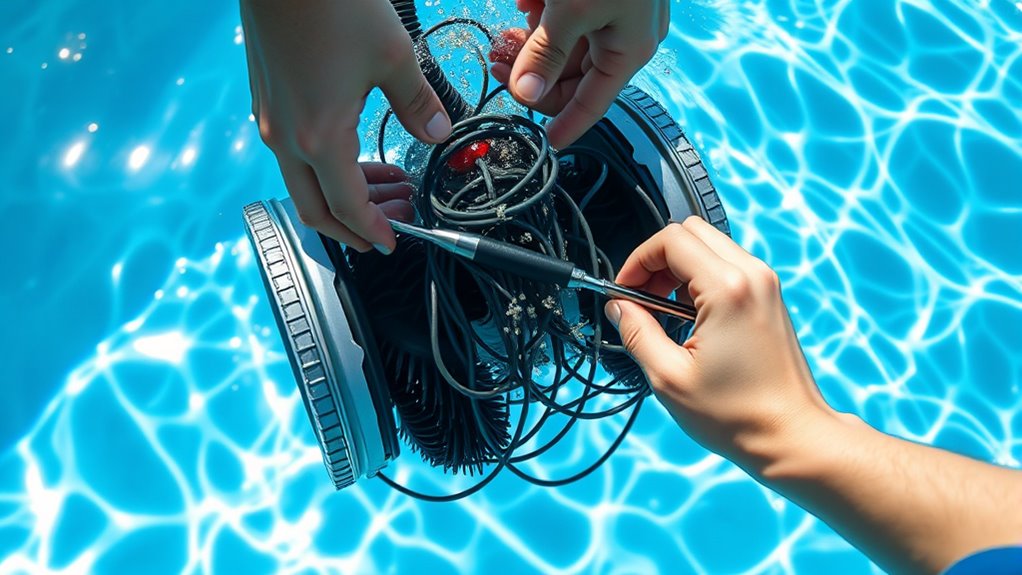If your automatic pool cleaner isn’t working properly, start by checking the power source, making sure cords are secure or batteries are fully charged. Inspect the brushes and wheels for debris or obstructions, and clean or replace filters and hoses if needed. Clear any obstacles from the pool and reposition the cleaner. If issues persist, consider resetting the system or consulting the manual. Continue here to learn more about troubleshooting steps that can get your cleaner back in action.
Key Takeaways
- Check power connections, batteries, and cords for secure attachment and proper charge.
- Inspect and clean brushes, wheels, and remove debris to ensure smooth operation.
- Examine filters and hoses for clogs or leaks, and replace or tighten as needed.
- Clear obstacles around the pool and reposition the cleaner if it gets stuck.
- Perform resets and consult the manufacturer’s manual for specific troubleshooting steps.

Automatic pool cleaners can make maintaining your pool much easier, but when they stop working properly, it can be frustrating. The good news is that many issues are simple to diagnose and fix with some basic pool cleaner maintenance and common troubleshooting tips. Before calling for professional help, it’s worth taking a few minutes to inspect your cleaner and see if you can identify the problem yourself.
Start by checking the power source. Ensure the cleaner is plugged in properly if it’s corded, or that the batteries are charged if it’s battery-operated. Sometimes, the simplest solution is the right one. If your cleaner isn’t moving or functioning as it should, look at the power connections and make sure nothing is loose or damaged. For robotic cleaners, inspect the power supply and cords for any signs of wear or corrosion. If your cleaner runs but doesn’t seem to clean effectively, it might be a sign that it needs some routine pool cleaner maintenance.
Check the power connections and ensure batteries or cords are secure and undamaged.
Next, examine the brushes and wheels. Over time, debris and dirt can cause buildup, reducing the cleaner’s ability to move smoothly across your pool floor. Clean the brushes thoroughly, removing any trapped hair, algae, or debris. Check that the wheels spin freely and aren’t obstructed by grime or calcium buildup. If the wheels are stuck or not turning easily, lubricate or replace them as necessary. Proper automatic pool cleaner maintenance can extend the lifespan of your device and ensure optimal performance. Regular inspections can also help identify potential issues before they become major problems. A thorough understanding of the cleaner’s moving parts can help you troubleshoot more effectively.
Another common troubleshooting tip involves inspecting the filter or skimmer basket. A clogged filter can impair the suction or water flow, hampering your pool cleaner’s performance. Regularly clean or replace filters to keep water flowing efficiently. Also, verify that the hoses and connections are secure and free of leaks. Leaks can cause loss of suction, making the cleaner less effective or causing it to stop altogether. Tighten any loose fittings or replace damaged hoses.
If you notice that your pool cleaner is moving erratically or getting stuck, check for obstacles or debris in the pool that could be hindering its path. Clear the pool of large debris, such as leaves or toys, which might trap or block the cleaner. Sometimes, adjusting the cleaner’s navigation or repositioning it in a different part of the pool can improve its effectiveness. Maintaining a clean pool environment can greatly improve the cleaner’s ability to operate smoothly.
Finally, if you’ve gone through these common troubleshooting tips and your pool cleaner still isn’t performing well, consider resetting it or consulting the manufacturer’s manual for specific instructions. Regular pool cleaner maintenance, such as cleaning filters, brushes, and checking connections, can prevent many issues before they happen. Taking these simple steps ensures your automatic cleaner functions properly, saving you time and effort in maintaining a sparkling clean pool. Proper system calibration can also help optimize performance and extend the lifespan of your device. Being familiar with the performance tuning principles of your cleaner can help you make informed adjustments for better results.
Frequently Asked Questions
How Often Should I Replace My Automatic Pool Cleaner?
You should replace your automatic pool cleaner based on its maintenance schedule and replacement frequency. Generally, inspect it every few months for wear and damage. If you notice persistent issues or significant deterioration, it’s time for a replacement. Typically, a good-quality cleaner lasts about 3 to 5 years. Regular maintenance helps extend its lifespan, but don’t hesitate to replace it sooner if it no longer performs effectively or costs more in repairs.
Can I Use My Pool Cleaner on a Saltwater Pool?
You can definitely use your pool cleaner on a saltwater pool, but check its saltwater compatibility first. Most modern cleaners are designed to handle saltwater, but older models might require extra cleaner maintenance to prevent corrosion. Regularly inspect your cleaner for any signs of wear or corrosion, and rinse it thoroughly after use. This ensures maximum performance and longevity, keeping your saltwater pool sparkling clean with minimal hassle.
What’S the Best Way to Store My Pool Cleaner During Winter?
During winter, you should focus on proper winter storage to safeguard your pool cleaner. First, clean it thoroughly to remove dirt and debris. Then, dry it completely to prevent mold. Store it in a cool, dry place away from direct sunlight. This winter storage helps ensure your pool cleaner stays in good condition and is ready to go when swimming season returns. Proper pool cleaner protection is key to its longevity.
How Do I Troubleshoot Electrical Issues With My Cleaner?
Think of your pool cleaner’s electrical system as the nervous system of a robot; if it’s not functioning, nothing moves properly. To troubleshoot electrical issues, first check the power supply to verify it’s plugged in and working. Then, inspect the electrical wiring for loose connections or damage. If the cleaner still won’t operate, test the circuit with a multimeter. Sometimes, a simple reset or replacing a faulty cord restores everything.
Are There Eco-Friendly Replacement Parts Available?
When looking for eco-friendly parts for your pool cleaner, you’ll find that many brands now offer sustainable replacements made from environmentally conscious materials. These eco-friendly parts help reduce your carbon footprint while maintaining performance. Check with your manufacturer or eco-focused suppliers for options like biodegradable brushes or energy-efficient motors. By choosing sustainable replacements, you support environmental health and ensure your cleaner stays effective, all without compromising on quality or functionality.
Conclusion
Now that you’ve checked the common issues, your pool cleaner should be back in action. But what if it still doesn’t work as planned? Sometimes, the smallest problem can hide deeper inside, waiting to surprise you. Stay vigilant and keep an eye on its performance. With a little patience, you’ll uncover the mystery behind the glitch — and restore your pool’s sparkle. The next step might just be the key to flawless cleaning—are you ready to find out?










